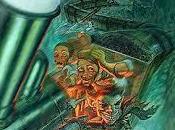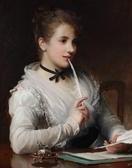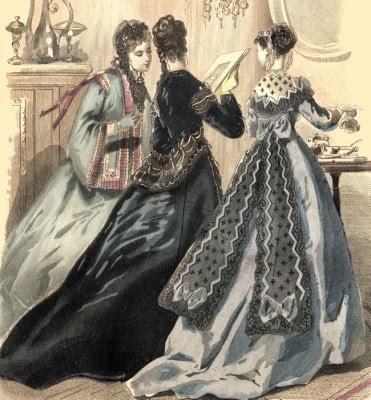
Col respiro caldo, che esalava in una nube leggera, la quale ascendeva allegra e graziosa nell'aria per andare a fermarsi nell'angolo del camino, come se quello fosse stato il suo cielo particolare, cantava la sua canzone con la robusta energia, frutto dell'allegrezza, che il suo corpo di ferro traeva dal fuoco; e perfino il coperchio, quel coperchio ribelle di poco prima - tale è l'influenza de' buoni esempi - eseguiva una specie di danza, battendo come un giovane timpano sordomuto che non avesse mai conosciuto l'esistenza del proprio fratello gemello.
Charles Dickens, Il Grillo nel focolare - Trillo primo, titolo originale dell'opera 'The Cricket on the Hearth. A Fairy Tale of Home' 1
Quello del riscaldare l'acqua, che viene successivamente passata nella teiera per intiepidirla appena e per creare la giusta umidità affinchè le foglie del tè, che immediatamente dopo vanno sul fondo a depositarsi, possano sprigionare appieno le proprietà benefiche e l'aroma che lo connotano, è il gesto con cui comincia il rito del tè ...
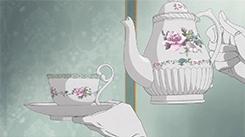
Per cercare di comprenderlo facciamo un passo indietro nel tempo per giungere fino all'epoca Regency che di tale rito vide il consolidarsi, un rito che aveva ed ha tutt'oggi un valore innanzitutto culturale e di costume; già trattando di come si svolgeva la vita ai tempi di Jane Austen e di quali fossero le consuetudini che ne governavano l'etichetta abbiamo visto il sorgere delle prime sale da tè che accoglievano dame aristocratiche desiderose di radunarsi per chiacchierare indisturbate gustando la bevanda, proveniente dalle lontane terre d'Oriente, che stava al tempo conquistando sempre maggior plauso.
Ma il tè agli inizi dell'ottocento era già da tempo di casa in Europa: risalgono alla seconda metà del XVI° secolo infatti primi cenni su questa bevanda recati nel vecchio continente da missionari e commercianti portoghesi, ma furono i mercanti olandesi, che sul finire del '500 cominciarono con l'intercettare le rotte commerciali portoghesi e istituirono sull'isola di Giava un porto franco, ad importare in Europa la bevanda cinese chiamata Tcha ( in alcune regioni veniva definita anche Tay o Tee' ); era per l'esattezza il 1606 quando la prima partita di tè lasciò Giava per raggiungere l'Olanda.
Tuttavia per moltissimo tempo, dato il costo che si mantenne elevato, il tè rimase una bevanda da aristocratici.
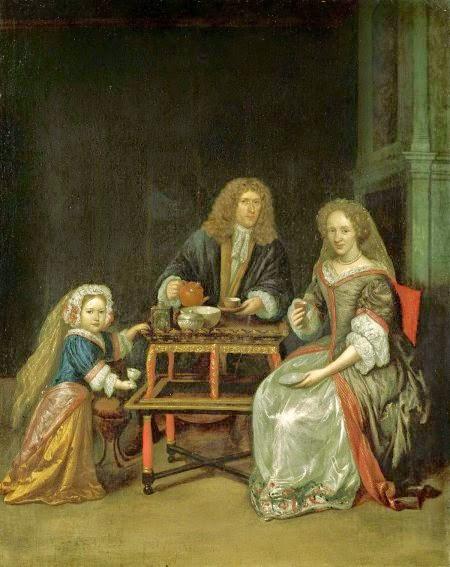
Dutch family taking tea, c. 1680, attribuito a Roelof Koets II (c. 1650-1725). ©Sotheby’s
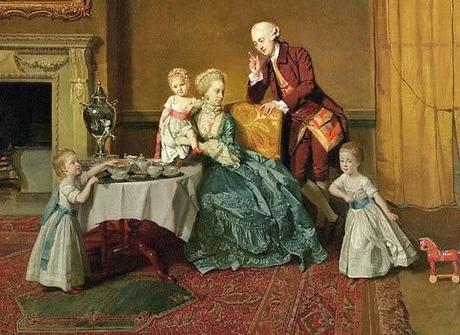
John, Lord Willoughby de Broke, and his Family, c 1766, by Johann Zoffany (1730 - 1810)
In Inghilterra, oggi considerata la patria del tè, non se ne parlò ampiamente prima del 1658, quando un trafiletto pubblicitario, apparso sul 'Mercurius Politicus', un periodico londinese, ne decantava le virtù medicamentose ed il potere contemplativo, ma a dare decisivo impulso alla diffusione del tè nelle isole Britanniche fu il matrimonio di Carlo II d'Inghilterra con Caterina di Braganza avvenuto nel 1662: la principessa portoghese, già avvezza al consumo dei questa bevanda tanto da recarne in Inghilterra, insieme con la propria dote, un'intera botte, ne favorì la diffusione dapprincipio presso le dame di corte, e poi, facendone quasi un fenomeno di cultura, presso l'intero popolo britannico: circolava al tempo voce che il tè possedesse proprietà terapeutiche (diceva Confucio: Il tè tempera lo spirito ed armonizza la mente, dissipa la spossatezza e allevia la stanchezza, risveglia il pensiero e impedisce la sonnolenza, alleggerisce e rinfresca il corpo, e rischiara le facoltà percettive.).) e Thomas Garraway, che fu il primo ad introdurne l'uso nella sua Coffe House di Londra nel 1657, ne faceva propaganda dicendo che l'uso ne fosse raccomandato da tutti medici cinesi; pensate che solamente pochi anni dopo, nel 1664, la compagnia Delle Indie Orientali importava in Gran Bretagna da Giava per la prima volta, una quantità di 100 lb ( circa 50 kg) di tè cinese nel suo primo ordine della storia. Anche qui, però, le foglie del tè trovarono dapprincipio, in una forte tassazione che si fece via via sempre più alta e gravosa ( dal 25 al 119 per cento ), un notevole ostacolo alla propria divulgazione, cosa che ne alimentò così, con il trascorrere del tempo, il contrabbando e la contraffazione: gli inglesi del tè non potevano ormai più fare a meno.
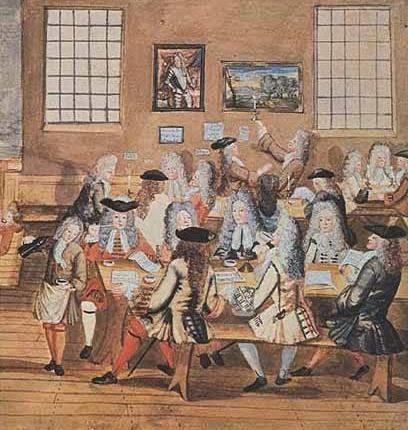
Una Coffe House in una stampa dei primi del settecento, luogo di ritrovo per soli uomini
La svolta definitiva nel consumo della prestigiosa bevanda ambrata profumata di terre lontane si ebbe nel 1706, quando Thomas Twining decise di ampliare la propria attività acquistando un locale in cui vendere caffè e te sfusi al fianco di una Coffe House molto frequentata, un locale tutt'ora esistente aperto a tutti, donne comprese ( alle Coffe House potevano accedere solo uomini ): fu quella la sua fortuna, quella del tè e dei suoi amatori.

Solamente nel 1784 il ministro William Pitt il giovane si avvide dell'esigenza di abbassare la tassa nel tentativo di attenuare il traffico malavitoso che aveva alimentato facendola scendere così al 12,5 per cento e si dice che, in una sola notte, tale provvedimento ne mutò le sorti, non solo in Inghilterra, ma anche nelle Americhe dove gli emigrati di madre lingua inglese si erano arrangiati trovando in casa propria un surrogato del tè nel Ceanothus americanus2: se è vero che continuò a circolare ancora per qualche tempo la voce che voleva che il nobile infuso procurasse tristezza e malinconia, con il finire del XVIII secolo esso vide incrementare la propria celebrità ed il proprio consumo tanto che lo si beveva anche nelle Coffè Houses più di quanto non si bevesse lo stesso caffè: spesso consumato con l'aggiunta di latte o di due tuorli sbattuti, gli inglesi, incuranti delle tradizioni che ad esso il mondo orientale aveva consegnato, inauguravano un modo del tutto innovativo di apprezzarne il sapore e le proprietà.
In poco tempo soprattutto le ladies divennero fanatiche bevitrici di tè e, secondo la tradizione, fu proprio una donna, Anna Russel, Duchessa di Bedford,
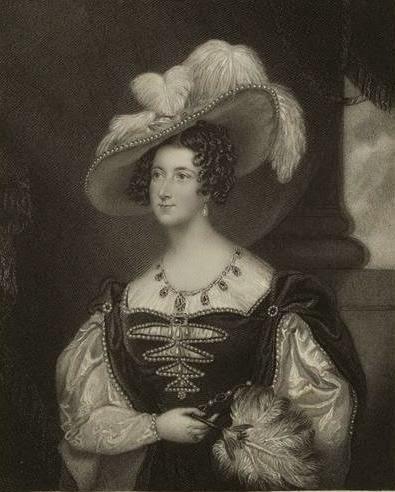
La Duchessa di Bedford, c 1820
grande amica della Regina Victoria, ad inventare la moda dell'afternoon tea, il famoso e tradizionale tè pomeridiano delle signore che in epoca vittoriana consolidò la propria valenza di rito di costume
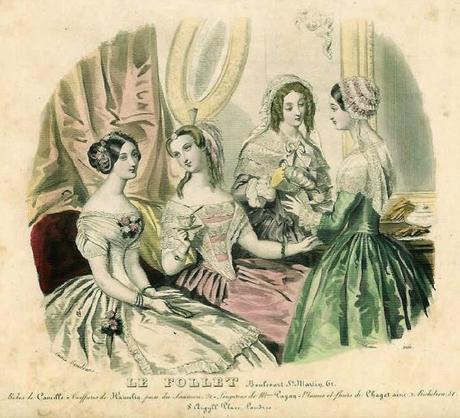


Five O'clock Tea, Julius LeBlanc Stewart (1855 - 1919)
qualificandosi come occasione unica per intrattenere relazioni sociali da che le ladies del tempo cominciarono con lo scambiarsi vicendevolmente visite con lo scopo di bere tè: preparato in cucina dalla servitù spettava alla padrona di casa il compito di servirlo nella maniera il più possibile raffinata, utilizzando il servizio più prestigioso, spesso con teiera, lattiera e zuccheriera in argento o sheffield,
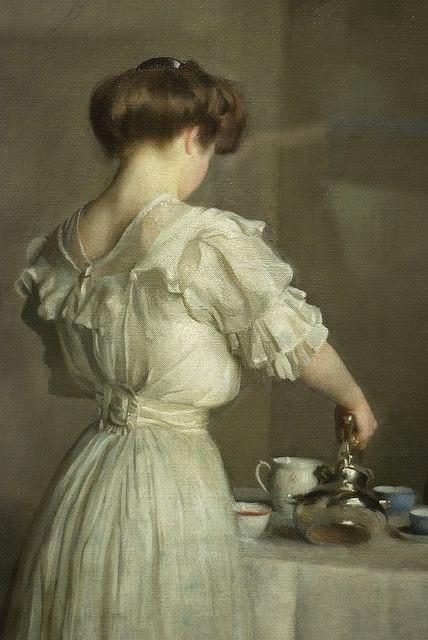
accompagnandolo con sandwiches, toast e pasticcini preparati in casa, immancabili gli Scones, serviti con panna semi montata all'uso inglese, morbide marmellate, Lemon-Curd.
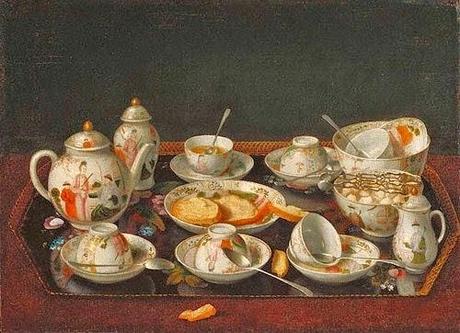
"L'Afternoon tea dovrebbe essere corredato di provviste fresche, sottili fette di pane e burro, dolci fantasia, torte, ecc, da essere portate non appena altri ospiti sopraggiungono."
― Isabella Beeton, Mrs Beeton's Book of Household Management
e nessuno, nessuno resisteva alla tentazione rappresentata da una tazza di buon tè caldo ...

Tea Time by Arthur John Elsley (1860 - 1952)
There are few hours in life more agreeable than the hour dedicated to the ceremony known as afternoon tea.
Henry James (1843 - 1916)
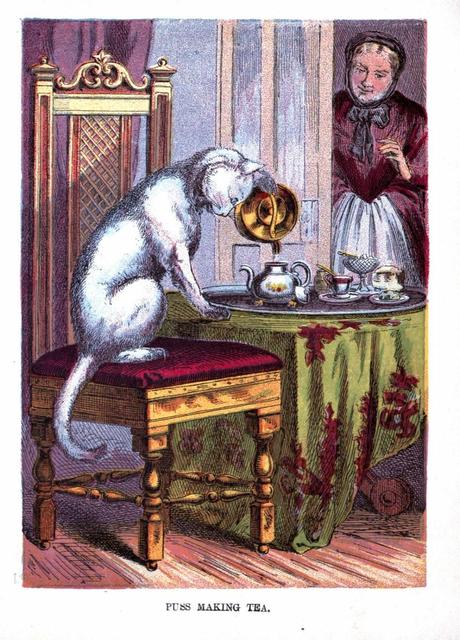
I smile, of course, And go on drinking tea."Yet with these Aprile sunsets, that somehow recallMy buried life, and Paris in the Spring,I feel immeasurably at peace, and find the worldTo be wonderful and youthful, after all."
Thomas Stearn Eliot (1888 - 1956)
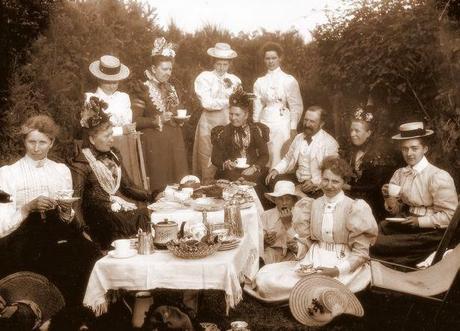
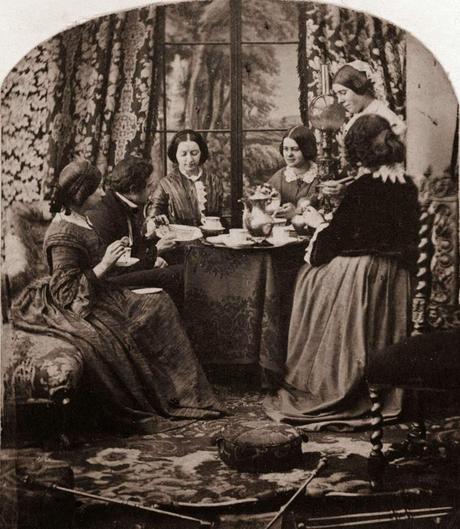
Victorian Afternoon Tea, c1858
Definito dapprincipio con l'appellativo di Low Tea perchè servito sul tavolino del caffè, di dimensioni piuttosto contenute, e, se in casa, nella parte più bassa del soggiorno, quando finirà con il divenire l'occasione di un piccolo pasto il tè del pomeriggio, servito tra le 16.00 e le 17.00, e tutto quanto lo accompagnava, farà di sè bella mostra direttamente sul tavolo del soggiorno o della sala da pranzo e ne diventerà quindi sinonimo il termine High Tea ....

High Tea,
Henriëtte Ronner-Knip (1821 - 1909)L'ora del te' fumante e dei libri chiusi, la dolcezza di sentire la fine della sera, la stanchezza incantevole e l'adorata attesa dell'ombra nuziale e della dolce notte.Paul Verlaine (1844 - 1896)
Ringraziandovi per avermi fatto compagnia in questo breve viaggio nella storia dell'ambrata bevanda proveniente dalle favolose terre d'oriente, compiuto tra tradizione, arte, cultura, vi saluto caramente augurandovi tanta, tanta serenità.
A presto ♥
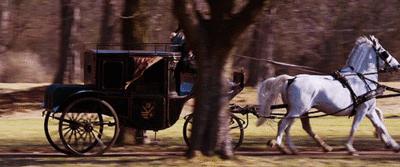

Note e citazioni:
1 - Charles Dickens, Il Grillo nel focolare - Trillo primo, Racconti di Natale, Arnoldo Mondadori Editore S.p.A., Milano, 1990, pag 106
2 - In un articolo apparso il 21 Novembre 1768 sul Boston Gazette si leggeva "Il tè ricavato da una pianta o arbusto ( Ceanothus americanus) coltivato in Pearsontown a circa 20 miglia da Portland, nel Maine, è stato servito in un circolo di signore e signori a Newbury Port, i quali sostengono che sia quasi, se non del tutto, simile se non uguale nel sapore al Bohea [ uno dei tre tè neri cinesi importati in America nel 1773 . Una così importante scoperta cattura l'attenzione, soprattutto in questa periodo di crisi. Se possediamo le piante, siamo in grado di fare un tè di nostra produzione ".
Nel 1774, Manasse Cutler scrisse del Liberty Tea chiamato Tea del New Jersey ( Ceanothus americanus)" Le foglie di questo arbusto sono state usate diffusamente dalla gente comune, in alcune parti del paese e nell'Indian Tea Room, ed è, forse, il miglior sostituto del tè che il paese offra. Essi immergono le foglie fresche in un decotto bollente fatto delle foglie e dei rami della stessa pianta, e poi le asciugano con un calore dolce. Il tè che ne ricavano, quando le foglie sono curate in questo modo, ha un sapore gradevole, e lascia un retrogusto alquanto simile a quello del tè Bohea " .
LE CITAZIONI SONO TRATTE DAL VOLUME 365 Things Every Tea Lover Should Know, By Harvest House Publishers, 2008
Bibliografia:
365 Things Every Tea Lover Should Know, By Harvest House Publishers, 2008 ( breve edizione disponibile on-line qui )
Isabella Beeton, Mrs. Beeton's Book of Household Management (Comprising Information for the Mistress, Housekeeper, Cook, Kitchen-maid, Butler, Footman, Coachman, Valet, Upper and under house-maids, Lady’s-maid, Maid-of-all-work, Laundry-maid, Nurse and nurse-maid, Monthly, wet, and sick nurses, etc. etc. - also, sanitary, medical, & legal memoranda;) with a history of the origin, properties, and uses of all things connected with home life and comfort., S. O. Beeton Publishing, London, 1861
- disponibile on-line al seguente indirizzo: http://ebooks.adelaide.edu.au/b/beeton/isabella/household/Michael Smith, The Afternoon Tea Book, Atheneum Publisher, 1986

- picture 1
With a warm breath, exhaled it in a light cloud, which ascended cheerful and gracious in the air to stop going into the corner of the fireplace, as if that was its particular sky, it sung its song with a robust energy, fruit of the joy, that its iron body drew from the fire; and even the lid, the lid slightly rebellious a little before - such is the influence of the good examples - performed a sort of dance, beating like a young deaf-mute drum who had never known the existence of its twin brother.
1That of heating the water, which is then passed into the teapot for just make it warm and create the right moisture for the leaves of the tea, that immediately after will go to settle on the bottom, could release the full aroma and the beneficial properties that characterize them, is the gesture with which the ritual of tea begins ...
- picture 2
To try and understand it let's take a step back in time to arrive to the Regency era that saw the consolidation of this ritual, a ritual that had and still has a primarily cultural and moral value; already dealing with how life in the time of Jane Austen took place and what were the practices that governed the etiquette of that agewe we saw the rise of the first tearooms that welcomed aristocratic ladies who want to gather themselves to talk undisturbed while enjoying the drink, coming from the distant lands of the East, which at the time was gaining more and more acclaim.
But the tea in the early XIXth century was already for long been at home in Europe: they're dating back to the second half of the XVIth century in fact, the first signs of this drink brought to the old continent by Portuguese traders and missionaries, but they were the Dutch merchants, who at the end '500 began with the intercept the Portuguese trade routes and established a free port on the island of Java, to import in Europe the chinese drink called Tcha ( in some regions was also called Tay or Tee' ); it was exactly the year 1606 when the first batch of tea left Java to achieve the Netherlands.
However, for a very long time, since the cost was kept very high, the tea was a drink for aristocrats only.
- picture 3 - Dutch family taking tea, c. 1680, attribuito a Roelof Koets II (c. 1650-1725). ©Sotheby’s
- picture 4 - John, Lord Willoughby de Broke, and his Family, c 1766, by Johann Zoffany (1730 - 1810)
In England, now considered the homeland of tea, it wasn't spoken widely before 1658, when a blurb, appeared in the 'Mercurius Politicus', a London periodic, extolled its medicinal and contemplattive powers, but the turning point in the spread of tea in the British Isles was given by the marriage of Charles II to Catherine of Braganza that took place in 1662: the Portuguese princess, already accustomed to the consumption of this drink so much to carry in England , along with her dowry, a whole barrel of it, favored its spread at first among the ladies of the court, and then, making it almost a cultural phenomenon, at the whole British people: rumor was circulating at the time that tea had therapeutic properties ( Confucius said that Tea tempers the spirits and harmonizes the mind, dispels lasssitude and relieves fatigue, awakens thought and prevents drowsiness, lightens or refreshes the body, and clears theperceptive faculties ) and Thomas Garraway, who was the first to introduce its use in its Coffe House in London in 1657, did it propaganda saying that the use of tea was recommended by all Chinese doctors; you have to know that only a few years later, in 1664, the East India Company imported to Britain from Java for the first time, a quantity of 100 lb of Chinese tea in its first order in history.Even here, however, the tea leaves found at first, in a high rate of tax that became gradually more and more burdensome and excessive (from 25 to 119 percent), a major obstacle to its dissemination, which fed well, with the over time, to the smuggling and counterfeiting: English couldn't live without tea anymore.
In the British Isles the final breakthrough in the consumption of the amber drink with the scent of distant lands took place in 1706, when Thomas Twining decided to expand its business by purchasing a room in which to sell coffee and tea in bulk to the side of a very busy Coffe House, a local which still exists today open to everybody, including women (to Coffe House had access men only): that was his fortune, that of tea and of its amateurs.- picture 6
Queen Victoria's longlife friend, to invent the fashion of the afternoon tea, the famous and traditional ladies' tea that in the Victorian era consolidated its significance of costume ritual
- picture 8
- picture 9 - Afternoon Tea, George Goodwin Kilburne, 1897
- picture 10 - Five O'clock Tea, Julius LeBlanc Stewart (1855 - 1919)
- Isabella Beeton, Mrs. Beeton's Book of Household Management
- picture 13 - Tea Time by Arthur John Elsley (1860 - 1952)
There are few hours in life more agreeable than the hour dedicated to the ceremony known as afternoon tea.
Henry James (1843 - 1916)
I smile, of course, And go on drinking tea."Yet with these Aprile sunsets, that somehow recallMy buried life, and Paris in the Spring,I feel immeasurably at peace, and find the worldTo be wonderful and youthful, after all."
Thomas Stearn Eliot (1888 - 1956)
- picture 16 - Victorian Afternoon Tea, c1858
Defined at first by the nickname of Low Tea because served on the coffee table, rather small in size, and, when at home, in the lower part of the living room, when it will end with becoming the opportunity for a small meal, afternoon tea served between 16.00 and 17.00, and all that went with it, will itself proudly displayed directly on the dining room table and will then named with the synonimus High Tea ....
The time of the steaming tea and of the closed books, the sweetness of feeling the end of the evening, fatigue lovely and the adored waiting of the wedding shadow and of the sweet night.
See you soon ♥
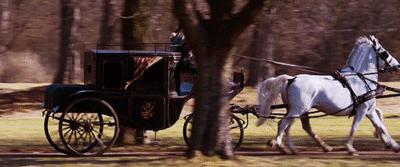

1 - Charles Dickens, The Cricket on the Hearth. A Fairy Tale of Home - Christmas Tales,
Arnoldo Mondadori Editore S.p.A., Milano, 1990, pag 106
2 - In an article published on November 21st, 1768 in the Boston Gazette they read: "Tea made from a plant or shrub (Ceanothus americanus) grown in Pearsontown about 20 miles from Portland, Maine, was served to a circle of ladies and gentlemen in Newbury Port, who pronounced it nearly, if not quite, its equal in flavor to genuine Bohea [one of three Chinese black teas tossed overboard later in 1773]. So important a discovery claims attention, especially at this crisis. If we have the plant, nothing is wanted but the process of curing it into tea of our own manufacture."
In 1774 , Manasseh Cutler wrote of Liberty Tea called New Jersey Tea ( Ceanothus americanus) "The leaves of this shrub have been much used by the common people, in some parts of the country, in the room of India tea; and is, perhaps, the best substitute the country affords. They immerse the fresh leaves in a boiling decoction of the leaves and branches of the same shrub, and then dry them with a gentle heat. The tea, when the leaves are cured in this way, has an agreeable taste, and leaves a roughness on the tongue somewhat resembling that of the bohea tea."
THE QUOTES ARE DRAWN FROM THE BOOK: 365 Things Every Tea Lover Should Know, By Harvest House Publishers, 2008
Bibliography:
365 Things Every Tea Lover Should Know, By Harvest House Publishers, 2008 ( short preview on-line here )
Isabella Beeton, Mrs. Beeton's Book of Household Management (Comprising Information for the Mistress, Housekeeper, Cook, Kitchen-maid, Butler, Footman, Coachman, Valet, Upper and under house-maids, Lady’s-maid, Maid-of-all-work, Laundry-maid, Nurse and nurse-maid, Monthly, wet, and sick nurses, etc. etc. - also, sanitary, medical, & legal memoranda;) with a history of the origin, properties, and uses of all things connected with home life and comfort., S. O. Beeton Publishing, London, 1861
- disponibile on-line here )Michael Smith, The Afternoon Tea Book, Atheneum Publisher, 1986
